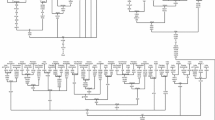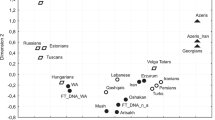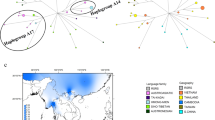Abstract
Throughout the history of modern humans, the current Kurdish-inhabited area has served as part of a tricontinental crossroad for major human migrations. Also, a significant body of archaeological evidence points to this area as the site of Neolithic transition. To investigate the phylogeography, origins and demographic history, mtDNA D-loop region of individuals representing four Kurdish groups from Iran were analysed. Our data indicated that most of the Kurds mtDNA lineages belong to branches of the haplogroups with the Western Eurasian origin; with small fractions of the Eastern Eurasian and sub-Saharan African lineages. The low level of mtDNA diversity observed in the Havrami group presented a bias towards isolation or increased drift due to small population size; while in the Kurmanji group it indicated a bias towards drift or mass migration events during the 5–18th century AD. The Mantel test showed strong isolation by distance, and AMOVA results for global and regional scales confirmed that the geography had acted as the main driving force in shaping the current pattern of mtDNA diversity, rather than linguistic similarity. The results of demographic analyses, in agreement with archaeological data, revealed a recent expansion of the Kurds (∼9,500 years before present) related to the Neolithic transition from hunting and gathering, to farming and cattle breeding in the Near East. Further, the high frequencies of typical haplogroups for early farmers (H; 37.1%) and hunter-gatherers (U; 13.8%) in the Kurds may testify the earlier hunter-gatherers in the Kurdish-inhabited area that adopted and admixed the Kurds ancestors following the Neolithic transition.



Similar content being viewed by others
References
Al-Zahery N., Saunier J., Ellingson K., Parson W., Parsons T. and Irwin J. 2013 Characterization of mitochondrial DNA control region lineages in Iraq. Int. J. Legal Med. 127, 373–375.
Azimzadeh-Irani M. 2011 Phylogeography and phylogenetic-linguistic relationship of the Iranian Tat groups using mtDNA D-loop region. MSc thesis, Faculty of Biological Sciences, Shahid Beheshti University, Tehran, Iran.
Bellwood P. and Oxenham M. 2008 The expansions of farming societies and the role of the Neolithic demographic transition in The Neolithic demographic transition and its consequences (eds. O. Bar-Yosef and J. P. Bocquet-Appel), pp. 13–34. Springer, Netherland.
Braidwood R. F. and Howe B. 1960 Prehistoric investigations in Iraq Kurdistan, 1st edition. University of Chicago Press, Illinois, USA.
Braidwood R. J., Cambel H., Redman C. L. and Watson P. J. 1971 Beginnings of village-farming communities in southeastern Turkey. Proc. Natl. Acad. Sci. USA 68, 1236–1240.
Bulloch J. and Morris H. 1992 No friends but the mountains, 1st edition. Viking Penguin, New York, USA.
Cardoso S., Valverde L., Alfonso-Sánchez M. A., Palencia-Madrid L., Elcoroaristizabal X., Algorta J. et al. 2013 The expanded mtDNA phylogeny of the Franco-Cantabrian region upholds the pre-neolithic genetic substrate of Basques. PLoS One 8, e67835.
Cavalli-Sforza L. L., Menozzi P. and Piazza A. 1994 The history and geography of human genes, 1st edition. Princeton University Press, Princeton, New Jersey, USA.
Cheng B., Tang W., He L., Dong Y., Lu J., Lei Y. et al. 2008 Genetic imprint of the Mongol: signal from phylogeographic analysis of mitochondrial DNA. J. Hum. Genet. 53, 905–913.
Comas D., Calafell F., Bendukidze N., Fananas L. and Bertranpetit J. 2000 Georgian and Kurd mtDNA sequence analysis shows a lack of correlation between languages and female genetic lineages. Am. J. Phys. Anthropol. 112, 5–16.
Cumberland R. C. 1926 The Kurds. Muslim World 16, 150–157.
Diamond J. and Bellwood P. 2003 Farmers and their languages: the first expansions. Science 300, 597–603.
Dixon P. 2003 VEGAN, a package of R functions for community ecology. J. Veg. Sci. 14, 927–930.
Excoffier L. and Lischer H. E. 2010 Arlequin, ver 3.5: a new series of programs to perform population genetics analyses under Linux and Windows. Mol. Ecol. Resour. 10, 564–567.
Fraumene C., Belle E. M., Castrì L., Sanna S., Mancosu G., Cosso M. et al. 2006 High resolution analysis and phylogenetic network construction using complete mtDNA sequences in Sardinian genetic isolates. Mol. Biol. Evol. 23, 2101–2111.
Fu Y. X. 1997 Statistical tests of neutrality of mutations against population growth, hitchhiking and background selection. Genetics 147, 915–925.
Fu Q., Rudan P., Pääbo S. and Krause J. 2012 Complete mitochondrial genomes reveal Neolithic expansion into Europe. PLoS One 7, e32473.
Gupta A. K. 2004 Origin of agriculture and domestication of plants and animals linked to early Holocene climate amelioration . Curr. Sci. 87, 54–59.
Hall T. A. 1999 BioEdit: a user-friendly biological sequence alignment editor and analysis program for Windows 95/98/NT. Nucleic Acids Symp. Ser. 41, 95–98.
Harpending H. 1994 Signature of ancient population growth in a low-resolution mitochondrial DNA mismatch distribution. Hum. Biol. 66, 591–600.
Hassanpour A. and Mojab S. 2005 Kurdish diaspora in encyclopedia of diasporas (ed. C. R. Ember, M. Ember and I. A. Skoggard), pp. 214–224. Springer, New York, USA.
Hoelzel A., Halley J., O’brien S., Campagna C., Arnborm T., Le Boeuf B. et al. 1993 Elephant seal genetic variation and the use of simulation models to investigate historical population bottlenecks. J. Hered. 84, 443–449.
Hurvich C. M. and Tsai C. -L. 1989 Regression and time series model selection in small samples. Biometrika 76, 297–307.
Ingman M. and Gyllensten U. 2006 A recent genetic link between Sami and the Volga-Ural region of Russia. Eur. J. Hum. Genet. 15, 115–120.
Irwin J. A., Ikramov A., Saunier J., Bodner M., Amory S., Röck A. et al. 2010 The mtDNA composition of Uzbekistan: a microcosm of Central Asian patterns. Int. J. Legal Med. 124, 195–204.
Izady M. R. 1992 The Kurds: A concise handbook, 1st edition. Taylor and Francis, London, UK.
Kloss-Brandstätter A., Pacher D., Schönherr S., Weissensteiner H., Binna R., Specht G. et al. 2011 HaploGrep: a fast and reliable algorithm for automatic classification of mitochondrial DNA haplogroups. Hum. Mutat. 32, 25–32.
Kumar S., Nei M., Dudley J. and Tamura K. 2008 MEGA: a biologist-centric software for evolutionary analysis of DNA and protein sequences. Brief Bioinform. 9, 299–306.
MacKenzie D. N. 1962 Kurdish dialect: studies, 1st edition. Oxford University Press, London, UK.
Madih A. A. 2007 The Kurds of Khorasan. Iran Caucasus 11, 11–31.
Malyarchuk B., Derenko M., Denisova G. and Kravtsova O. 2010 Mitogenomic diversity in Tatars from the Volga-Ural region of Russia. Mol. Biol. Evol. 27, 2220–2226.
Mantel N. 1967 The detection of disease clustering and a generalized regression approach. Cancer Res. 27, 209–220.
Meri J. W. 2005 Medieval Islamic civilization: an encyclopedia, 1st edition. Routledge, New York, USA.
Meyer S., Weiss G. and von Haeseler A. 1999 Pattern of nucleotide substitution and rate heterogeneity in the hypervariable regions I and II of human mtDNA. Genetics 152, 1103–1110.
Mielnik-Sikorska M., Daca P., Malyarchuk B., Derenko M., Skonieczna K., Perkova M. et al. 2013 The history of Slavs inferred from complete mitochondrial genome sequences . PLoS One 8, e54360.
Nasidze I., Quinque D., Ozturk M., Bendukidze N. and Stoneking M. 2005 MtDNA and Y-chromosome variation in Kurdish groups. Ann. Hum. Genet. 69, 401–412.
Posada D. 2008 jModelTest: phylogenetic model averaging . Mol. Biol. Evol. 25, 1253–1256.
Quintana-Murci L., Chaix R., Wells R. S., Behar D. M., Sayar H., Scozzari R. et al. 2004 Where west meets east: the complex mtDNA landscape of the southwest and Central Asian corridor. Am. J. Hum. Genet. 74, 827–845.
Ramos-Onsins S. E. and Rozas J. 2002 Statistical properties of new neutrality tests against population growth. Mol. Biol. Evol. 19, 2092–2100.
Richards M., Macaulay V., Hickey E., Vega E., Sykes B., Guida V. et al. 2000 Tracing European founder lineages in the Near Eastern mtDNA pool. Am. J. Hum. Genet. 67, 1251–1276.
Schönberg A., Theunert C., Li M., Stoneking M. and Nasidze I. 2011 High-throughput sequencing of complete human mtDNA genomes from the Caucasus and West Asia: high diversity and demographic inferences. Eur. J. Hum. Genet. 19, 988–994.
Sigurðardottir S., Helgason A., Gulcher J. R., Stefansson K. and Donnelly P. 2000 The mutation rate in the human mtDNA control region. Am. J. Hum. Genet. 66, 1599–1609.
Slatkin M. and Hudson R. R. 1991 Pairwise comparisons of mitochondrial DNA sequences in stable and exponentially growing populations. Genetics 129, 555–562.
Tajima F. 1989 Statistical method for testing the neutral mutation hypothesis by DNA polymorphism. Genetics 123, 585–595.
Tamura K. and Nei M. 1993 Estimation of the number of nucleotide substitutions in the control region of mitochondrial DNA in humans and chimpanzees. Mol. Biol. Evol. 10, 512– 526.
Team R. C. 2012 R: A language and environment for statistical computing. R Foundation for Statistical Computing, Vienna, Austria.
Van Oven M. and Kayser M. 2009 Updated comprehensive phylogenetic tree of global human mitochondrial DNA variation. Hum. Mutat. 30, E386–E394.
Volodko N. V., Starikovskaya E. B., Mazunin I. O., Eltsov N. P., Naidenko P. V., Wallace D. C. et al. 2008 Mitochondrial genome diversity in arctic Siberians, with particular reference to the evolutionary history of Beringia and Pleistocenic peopling of the Americas. Am. J. Hum. Genet. 82, 1084–1100.
Weber D., Stewart B. S., Garza J. C. and Lehman N. 2000 An empirical genetic assessment of the severity of the northern elephant seal population bottleneck. Curr. Biol. 10, 1287–1290.
Yang L., Tan S., Yu H., Zheng B., Qiao E., Dong Y. et al. 2008 Gene admixture in ethnic populations in upper part of Silk Road revealed by mtDNA polymorphism. Sci. China C Life Sci. 51, 435–444.
Zarei F. 2013 Phylogeography and phylogenetic-linguistic relationships of the Iranian Kurds using mtDNA D-Loop region. MSc thesis, Faculty of Biological Sciences, Shahid Beheshti University, Tehran, Iran.
Zeder M. A. and Hesse B. 2000 The initial domestication of goats (Capra hircus) in the Zagros Mountains 10,000 years ago. Science 287, 2254–2257.
Acknowledgements
We are grateful to all the original donors for providing blood samples, Esmail Majidi and Maryam Maali for assisting in the sampling, and Hassan Nazari for linguistic editing. We appreciate the anonymous reviewers for their valuable suggestions on the manuscript. This work which was extracted from a master thesis, supported in part by Faculty of Biological Sciences, Shahid Beheshti University.
Author information
Authors and Affiliations
Corresponding author
Additional information
Corresponding editor: RAJIVA RAMAN
Zarei F. and Rajabi-Maham H. 2016 Phylogeography, genetic diversity and demographic history of the Iranian Kurdish groups based on mtDNA sequences. J. Genet. 95, xx–xx
Rights and permissions
About this article
Cite this article
ZAREI, F., RAJABI-MAHAM, H. Phylogeography, genetic diversity and demographic history of the Iranian Kurdish groups based on mtDNA sequences. J Genet 95, 767–776 (2016). https://doi.org/10.1007/s12041-016-0692-4
Received:
Revised:
Accepted:
Published:
Issue Date:
DOI: https://doi.org/10.1007/s12041-016-0692-4




